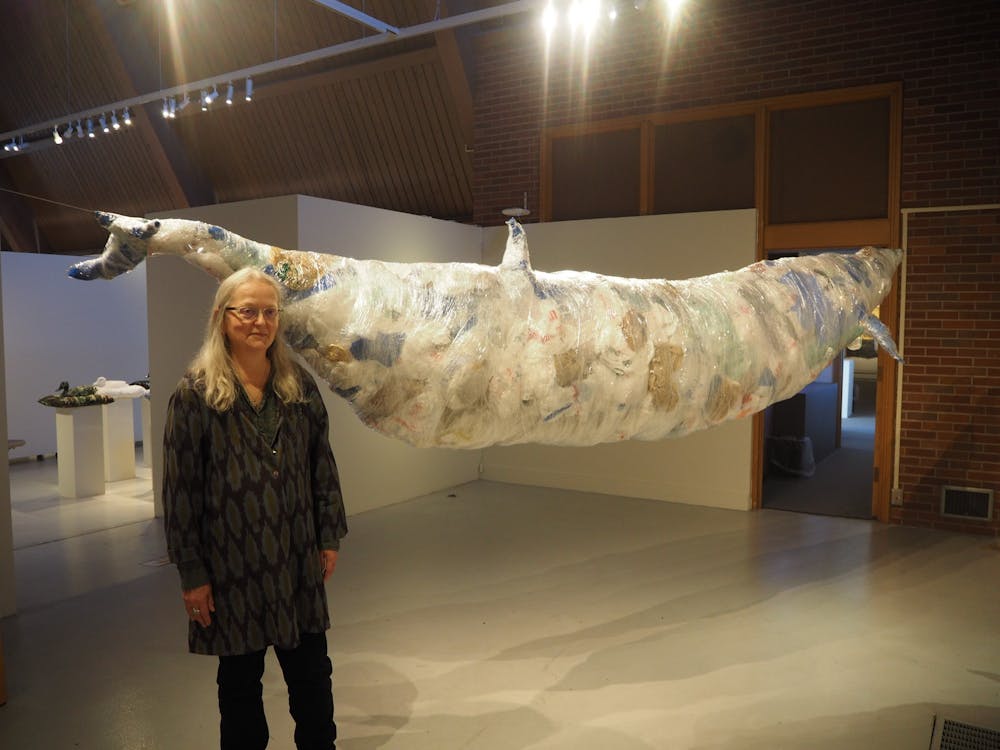Q&A: University Art Gallery director discusses journey, importance of art
Inside a converted A-frame church lays a hidden gem of Central Michigan University.
A wealth of art and culture hangs inside the University Art Gallery. Along the back wall, a display of twisted plastics and fabrics shows the possibilities of shape and texture.
To the right of this display, another wall is occupied with paints so full of texture they almost pop out from the wall.
Further into the gallery is an office busy with artistic materials and shipping boxes. Sitting at a desk, nestled within the chaos, is a woman adorned in black cover-alls and a dress coat.
Gallery director, Anne Gochenour, has been in charge of presenting art to the CMU community for 14 years. Having lived across the United States for both work and school, Gochenour has experienced everything from working in health care to attending graduate school for fine art in Iowa.
The one constant in her life has been art.
Gochenour is a trained artist that has worked in museums as a curator of contemporary art for 11 years, along with creating her own work.
Now, she creates art that brings to light the environmental threats of plastic and what art means for the people that enjoy it.
Central Michigan Life spoke with Gochenour about her art, experiences and running a gallery.
What inspired you to get into art in the first place?
I guess it was my language. When you look back, I was constantly doing murals for my walls at home and I felt good making (art).
What kind of art did you do in your undergraduate years at William & Mary?
I took a lot of painting, but I kind of knew I was a 3D artist. But I took painting so that I would actually study it because it's hard to do. Then my senior year I kind of decided I want to continue with the art. I decided in January and things were due in February. I got into five out of the six places I applied to.
I remember the faculty said 'Well, don't be too disappointed if you don't get in' and I'm like 'Thanks for the support'. Then I went to the University of Iowa.
I saw that you were working as a curator as well?
I worked at the Arkansas Art Center for 12 years. I got started exhibiting art as an undergraduate, for senior show. I remember helping another student and I really started talking about what's the right way to hang the show up.
Do you think hanging gallery art is its own form of art?
It is creative, and it's kind of been my art for 20 years. I still make pieces but haven't had the time.
When I had a baby and my full-time job, I thought, instead of feeling guilty about everything, I'll put my artmaking on sabbatical.
Tell me about your transition to environmentally focused art.
Have you seen the whale? It was (made out of) the amount of plastic found in a dead whale.
(Plastic in the dead whale) was 88 pounds, and I didn't even get to 88 pounds. I had to stop because it was at 15 feet and as big as I wanted it.
I was saving plastic because I'm really upset with how much plastic I use.
So I was thinking of different ways of handling the plastic and then I was cleaning off my table and there was a clipping from the New York Times that talked about (the dead) whale.
Do you think the art department has been shrinking over the years?
It has been shrinking. It's a good art department. And one of the things that the students get when they come here is a lot of attention. The thing I admire is the quality of the work for those shows.
(The student's art) does not look like their teachers, so the professors are really focusing on (the students) voice and developing that.
What do you think society loses out on when you lose funding for artists who want to explore their medium?
Being human, it's the richness of life. We're sitting there being entertained a whole lot. And all that entertainment, the quality of the entertainment, it's artists (doing it).
What do you think the public could gain by coming to the gallery?
It's a different form of communication. They might come in and think that's just kind of weird or something. But I don't get that from all the students, I think they're just kind of intrigued to see what people are thinking about making.




